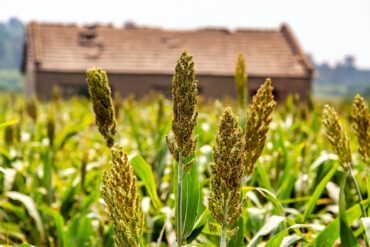Are your gardening efforts limited to flowers, grass, fruits and vegetables? Grains are another exciting plant to cultivate. Knowing which grains to grow in the garden can reward your efforts with a successful, verdant crop. The trick is knowing what mistakes to avoid that could ruin your harvest. It’s time to go “with” the grain.
Grains to Grow in the Garden
While you may be familiar with the large-scale mechanized farming operations that make up most of the commercial production, grains are happy to grow and thrive in pots and smaller plots of land. As long as they root in a climate that suits a particular species, these grassy plants do exceedingly well.

Some of the best grains to grow in your backyard include:
- Wheat
- Corn
- Millet
- Amaranth
- Rye
- Acorns
- Sorghum
A significant challenge is where to get the grains you’d like to grow. Not all seeds bought in a supermarket will germinate since grass seeds without hulls are a no-grow. However, you can often buy smaller quantities from online or local feed stores. If you’re growing grains for ornamental purposes, you can choose a mixed variety of bird seeds, which usually have their hulls intact.
5 Common Mistakes When Growing Grain
Like most grass species, grains grow reasonably well with minimal effort, but a few gardening mistakes for beginners can stunt a crop or lead to a poor harvest. With some basic knowledge, you and your fruity grasses will indeed thrive.
1. Planting a ‘Wrong Weather’ Crop
Grains feature two groups — warm-weather and cold-weather crops. As the name suggests, only plant cold-weather grasses near or during cooler weather. They thrive at lower temperatures and the accompanying rainfall patterns. Likewise, planting warm-weather crops like corn and sorghum during cold weather won’t help them, as they require warmer temperatures and longer sunny days to germinate and grow.
2. Underestimating the Yield
Some home-growers underestimate just how much grain a patch will produce. A standard backyard with grasses planted in neat rows will produce enough to grind into flour for several loaves of bread. Some grass species can grow quite tall, which may be intimidating if you’re not used to it.
Companion planting can help you keep some space and help the plants fight off insects. The classic triad of beans, squash and corn works well together.
3. Overwatering
Many gardeners tend to overwater their plants, and while flowers may thrive with a little extra, grass species can suffer severe damage from excessive watering. Root rot and mold are more serious problems when their conditions are too wet.
Use a hygrometer to measure the soil moisture before you water. Most grains prefer to grow on a well-draining substrate. If the top inch is dry, you can water thoroughly.
The exception is rice, which prefers to grow in wet soil. You don’t have to create a “paddy” for your rice production — planting it in a large ceramic container can help prevent dryness and ensure this water-loving grain thrives. The pot’s color changes can also help you tell how dry the soil is.
4. Underfertilizing
Grains are greedy crops, especially the fast-growing varieties. Fertilizing the soil before planting is ideal. Some prefer a good organic fertilizer like composted manure, but chemical fertilizers can burn the seeds when germinating.
Apply a good-quality organic fertilizer or compost to the top layer of your garden soil before tilling. If the ground is very dry and low in nutrients, you may need to analyze a soil sample to check which minerals it’s deficient in.
5. Forgetting to Weed
The grass may hide pervasive weeds, but you should do your best to remove these by hand, as they could interfere with your crop’s growth. Weeds compete with the grains for nutrients, and if they start locking the soil, it can also affect drainage.
Weed thoroughly before seeding your crop. When germinating, place a thin layer of straw over the soil to stop weeds from outgrowing them. As a bonus, this also protects the seeds from opportunistic birdlife.
Watch Out for These Grain Gardening Mistakes for Beginners
Grains are a low-maintenance way to fill space in your backyard garden. If you plant them correctly, they can provide a substantial harvest or a lovely ornamental layer. Potted grasses add height to a space, while the grain fruits create a beautiful, light-catching effect.
Take care to water them correctly and choose the best seasonal variety to plant. Happy growing!


























